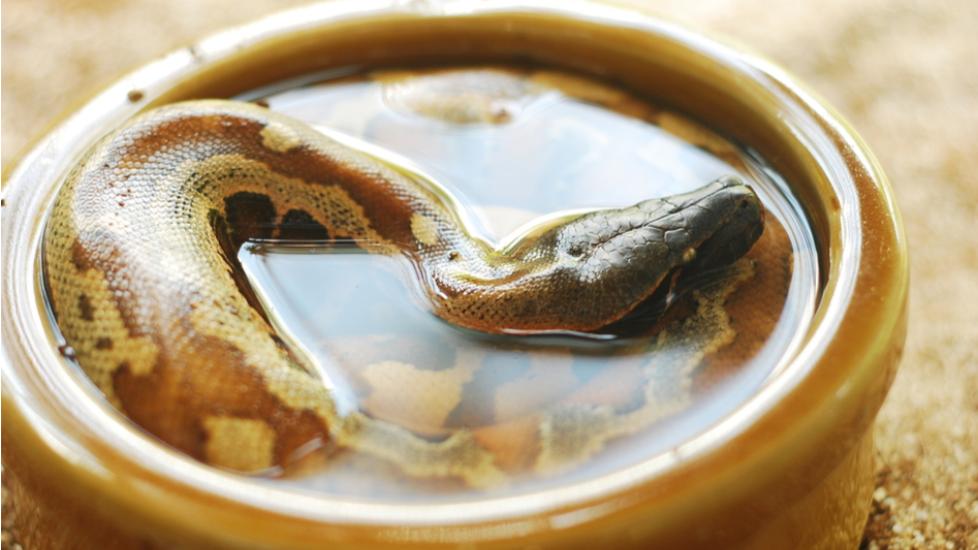How to Bathe Your Reptile
By Dr. Laurie Hess, DVM, Diplomate ABVP (Avian Practice)
Reptiles, unlike mammals, can absorb water through their skin. So, to stay hydrated, they don’t have to drink but simply can bathe. Wild reptiles bathe themselves, but pet reptiles must be given proper tools to do this.
How an owner bathes a pet reptile depends, to some extent, on the species. However, a few rules apply to bathing all reptiles, regardless of species. First, only water should be used – without any type of cleanser or soap. Second, reptiles often defecate in their water dishes after soaking, so it is important that the water in these dishes be freshened regularly. Third, lukewarm or tepid water, comfortable to the touch, is best. Reptiles are homeotherms, meaning they adjust their body temperatures to that of their surroundings. Thus, if they soak in water, it should neither be too hot nor too cold. Fourth, a 10-minute soak is adequate for most reptiles, regardless of species. Longer than that may lead to wrinkly, excessively soft skin like we get when we stay in the tub too long. Finally, the water should be deep enough to immerse the reptile’s body but not so deep as to prevent it from keeping its head above water.
Care should be taken when bathing sick reptiles who are too weak to raise their heads; these animals should be bathed in shallow water and monitored carefully when bathing to ensure that they don’t drown.
Lizards Need Soaking bowls
In general, lizards, regardless of species, should be provided with a shallow, open bowl of water into which they can climb and soak if they choose. Most species, even desert ones, enjoy this and will soak from time to time.
If lizards do not soak on their own, and they are shedding skin, owners should place them in a shallow water bowl to soak, or they can mist their lizard gently with a plant mister 2-3 times per week to encourage shedding. Bearded dragons, in particular, often retain skin around their fingers and toes, as well as on their tail tips and around their eyes, and soaking or misting can help small pieces of retained skin come off.
If retained skin doesn’t come off with repeated soaking, owners should not attempt to pull or brush off the skin, as pulling may damage the underlying muscle or bone. Rather, the lizard should be checked out by a veterinarian to ensure that the skin isn’t infected and to see if treatment is necessary.
Give Tortoises the Option to Bathe Themselves
Tortoises, by definition, live on land. Many species of tortoise naturally live in the dry desert and do not regularly bathe. Regardless, pet tortoises should have an open, shallow bowl of water in their tanks from which they can drink or soak if they choose. Typically, tortoises’ shells stay dry and clean and do not need to be brushed as do those of turtles.
Keeping Your Turtle’s Shell Clean
By definition, turtles live in water, so they need a large, deep area in their tanks to swim and dive, as well as an area on to which they can climb to get out of the water. They do not need a separate bowl from which to drink or soak. Water temperature depends on the turtles’ species; for the commonly kept red eared slider turtle, water temperature should be maintained with a water heater in the mid- to low-70s°F. A filter is critical to remove discarded food and waste from the water, and the filter should be changed at least monthly, depending on the size of the tank and the number of turtles housed in it.
Many pet turtles develop a green or brown slimy coating of algae, bacteria, or fungus on their shells that owners can gently brush off using a soft tooth brush and mild, non-medicated soap or a dilute solution of Lugol’s iodine (available at any drug store and mixed in small amounts with warm water to make a solution that looks like weak tea), as necessary. Discolorations of the shell that do not easily brush off should be checked out by a reptile-savvy veterinarian.
Snakes – Yes, They Like Baths Too
Most people don’t think that pet snakes need to bathe, yet many snakes enjoy soaking in a shallow tub of warm water. If their enclosures are large enough, snakes should be offered an open pan of water in which they can submerge themselves if they choose. If not, they can be misted lightly once or twice a week with a plant mister. If they are shedding and their skin isn’t shed off in one piece, soaking or misting them can help them shed retained skin.
***
Just as it does for us, bathing feels good for reptiles and provides them the added benefit of hydration as they absorb water through their skin. Bathing is critical to keeping a pet reptile healthy and is something most reptiles really enjoy.
